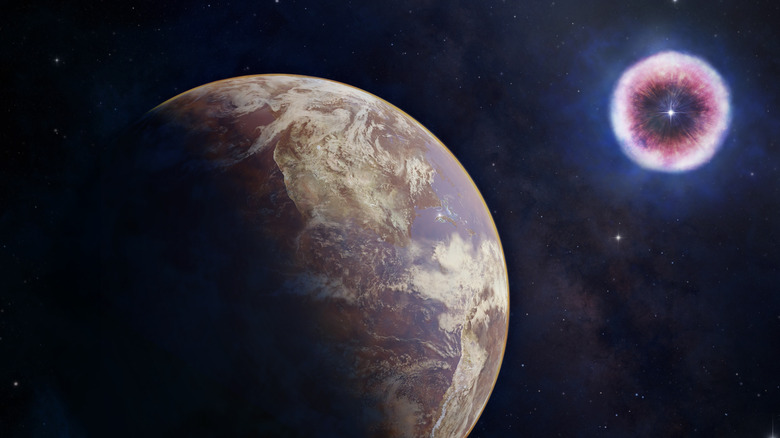Exploded Stars' Impact On Nearby Planets Is Even Worse Than NASA Thought
When a massive star runs out of fuel and approaches the end of its life, it can go supernova — meaning that it explodes in an epic cosmic event that sends energy streaming out into space across the electromagnetic spectrum including visible light, ultraviolet light, radio waves, and X-rays. This can be highly destructive, ripping apart nearby planets or rendering them uninhabitable. But the supernova explosion isn't the end of the threat to planets. Recent research using NASA's Chandra X-Ray Observatory shows that even long after the supernova has happened, there can still be a danger to planets within a few hundred light-years.
Astronomers already knew that planets could be impacted by a supernova explosion during two periods. Firstly they are threatened by the radiation coming from the star in the immediate wake of the explosion. And then there are the cosmic rays, or particles charged to high speeds, which can arrive thousands of years after the explosion and cause damage.
But now they know there is another period between these two when supernovas can damage the atmospheres of nearby planets. All supernovas give off some X-rays, but if the supernova happens to occur near a dense cloud of gas it can produce a huge wave of X-rays that can affect planets as far away as 160 light-years. "If a torrent of X-rays sweeps over a nearby planet, the radiation would severely alter the planet's atmospheric chemistry," said the lead author of the study published in The Astrophysical Journal, Ian Brunton of the University of Illinois at Urbana-Champaign. "For an Earth-like planet, this process could wipe out a significant portion of ozone, which ultimately protects life from the dangerous ultraviolet radiation of its host star."
The impact of supernovae on Earth
The researchers discovered this effect by studying X-ray observations of 31 supernovae, seeing how far the impacts of these explosions can reach. NASA is quick to point out that we don't need to worry about being the victim of a supernova stripping our atmosphere, as there are no potential supernovas near enough Earth to be a concern. For reference, a relatively nearby star predicted to go supernova relatively soon is Betelgeuse, but that is located around 650 light-years away, so it's too far away to cause problems here.
But our planet could have been hit by an X-ray blast from a supernova in the past. "The Earth is not in any danger from an event like this now, because there are no potential supernovae within the X-ray danger zone," said co-author Connor O'Mahoney of the University of Illinois. "However, it may be the case that such events played a role in Earth's past."
The evidence for this comes from a particular radioactive type of iron that is absent from some places on Earth, suggesting that two supernovae could have occurred between two and eight million years ago. Such an X-ray blast could cause terrible damage to the food chain, particularly by affecting marine life. NASA even suggests that the effects could potentially cause an extinction event — but it also points out that there is no evidence linking past extinction events like the death of the dinosaurs to the known supernovae events.
